Pink Floyd: Their Mortal Remains – V&A Publications
The Exhibition Pink Floyd: Their Mortal Remains is an immersive journey through the world of Pink Floyd. As with most shows at the Victoria &Albert Museum, it is touted to be an “indulgent and comprehensive” and by all accounts a highly popular and important experience.
So, it comes as no surprise that the accompanying book should be anything less. Sure, there are endless books about Pink Floyd. Why should this one be any different? What makes it better or worth the hefty investment? The book (also called Their Mortal Remains) is written and designed to be the official catalogue. Initially, I did think the title was a little cringe-worthy, given that two members of the band have now passed. But I guess this was an exhibition of physical worth, the commemoration of those mortal possessions and their contribution to culture. If not that, then what?
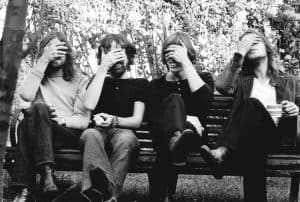 Sadly, my tour of the exhibition can only a virtual one so I’ve had to rely on reviews and blogs to get the full picture (http://pinkfloydexhibition.com). Of course, a good exhibit catalogue should not only contain lots of photographs that act as a memento for the exhibit, or in my case an extension for those that couldn’t make it. It should also contain additional materials that help you explore the subject of the exhibit in greater depth. For the most part, this book does both well. The book itself is big and gorgeous – beautifully designed and printed.
Sadly, my tour of the exhibition can only a virtual one so I’ve had to rely on reviews and blogs to get the full picture (http://pinkfloydexhibition.com). Of course, a good exhibit catalogue should not only contain lots of photographs that act as a memento for the exhibit, or in my case an extension for those that couldn’t make it. It should also contain additional materials that help you explore the subject of the exhibit in greater depth. For the most part, this book does both well. The book itself is big and gorgeous – beautifully designed and printed.
At 300 pages, most of them photographs, there’s plenty here for all types to ogle over – especially if you can’t see the exhibition in person. What we have here is the comprehensive documentation of how the group invented the modern concept of art rock and performance – not just the idea of pushing the boundaries of writing but the creation of a totally immersive theatre experience as well. Starting with a leniency toward psychedelic visuals it wasn’t long before they started to define their own genre of clever images, mixed with music and often optical illusions that challenged both the listener and society as a whole.
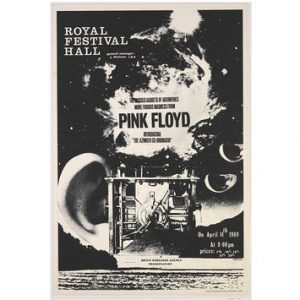 This book is rich on early history, especially, tracing everything from the band’s early London underground gigs to the making of their most famous albums – from Piper at the Gates of Dawn to The Endless River. The book is divided into two sections and a coda. The first contains essays on the history of the band, some excellent snapshots and recollections of the times surrounding the psychedelic era of which Pink Floyd was a huge influencer, as well as some on the spot and first-hand accounts and insights of the three eras of the band – the Syd Barrett era, the Roger Waters era, and the David Gilmour era – written by friends of the band, critics, scholars, and curators of the V&A Museum.
This book is rich on early history, especially, tracing everything from the band’s early London underground gigs to the making of their most famous albums – from Piper at the Gates of Dawn to The Endless River. The book is divided into two sections and a coda. The first contains essays on the history of the band, some excellent snapshots and recollections of the times surrounding the psychedelic era of which Pink Floyd was a huge influencer, as well as some on the spot and first-hand accounts and insights of the three eras of the band – the Syd Barrett era, the Roger Waters era, and the David Gilmour era – written by friends of the band, critics, scholars, and curators of the V&A Museum.
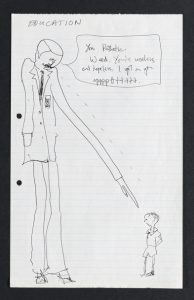 Topics extensively cover the band’s formation (nothing new here) and the underground scene that allowed it to find its sound in those early days (which was fascinating), and the development of the band’s music and sound through the years (elementary). Sometimes the essays read like a well- thumbed textbook. But, to their credit the individual voices ranging from conversational and storytelling to trainspotting details, ad nauseum. So, ultimately your enjoyment of each essay may depend on which facet of Pink Floyd history you personally dig and how much you really want to know.
Topics extensively cover the band’s formation (nothing new here) and the underground scene that allowed it to find its sound in those early days (which was fascinating), and the development of the band’s music and sound through the years (elementary). Sometimes the essays read like a well- thumbed textbook. But, to their credit the individual voices ranging from conversational and storytelling to trainspotting details, ad nauseum. So, ultimately your enjoyment of each essay may depend on which facet of Pink Floyd history you personally dig and how much you really want to know.
Pink Floyd’s visuals are a key focus of the exhibition – it is as much a celebration of the band’s iconic album art and theatrical live performances as it is their music. Scaled models of set designs are shown alongside inflatable puppets, music videos, animations, tour programmes and sketches for album covers, offering a look at the process and ambition behind the band’s visual output.
 The exhibition was conceived by the late Storm Thorgerson and developed by his Hipgnosis creative partner Aubrey ‘Po’ Powell (who contributes a short and sober overview in his Foreword). As part of the design team that created much of the band’s iconic album artwork, his recollections are a treat to read and probably one of the highlights, giving us yet another inside behind the wall of what made the Floyd tick. And his recollections of Thorgerson, which close the book are funny, insightful, and touching. They help illustrate the ebb and flow of some of the relationships that intertwined with the band over the years. To the outside world he was disorganised and chaotic, but he was to a degree like Barrett. A dreamer who with a particular clarity of vision. Apparently, the famous Dark Side prism was a last-minute knock up on the back of a napkin. He was keener to explore other ideas but the band was adamant.
The exhibition was conceived by the late Storm Thorgerson and developed by his Hipgnosis creative partner Aubrey ‘Po’ Powell (who contributes a short and sober overview in his Foreword). As part of the design team that created much of the band’s iconic album artwork, his recollections are a treat to read and probably one of the highlights, giving us yet another inside behind the wall of what made the Floyd tick. And his recollections of Thorgerson, which close the book are funny, insightful, and touching. They help illustrate the ebb and flow of some of the relationships that intertwined with the band over the years. To the outside world he was disorganised and chaotic, but he was to a degree like Barrett. A dreamer who with a particular clarity of vision. Apparently, the famous Dark Side prism was a last-minute knock up on the back of a napkin. He was keener to explore other ideas but the band was adamant.
“Storm always claimed he wasn’t a photographer and said he ‘couldn’t draw for toffee’. Ideas came to him in. “Plundering the goldmine,’ he used to say, meaning his busy mind.”
Joe Boyd (producer of Arnold Layne, 1967) was also there at the beginning of both the London underground scene of the 1960’s and Pink Floyd; and so his writing and photographs really bring to life all the parts that had to come together for there to even be a Pink Floyd. Here he goes into much greater depth than his limited screen time in the doco Behind the Wall (2011).
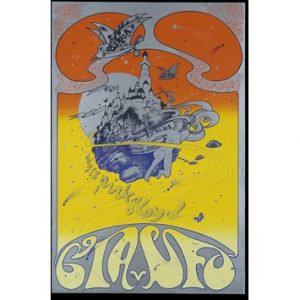 For the exhibition, itself the design company Stufish made up several large-scale installations, including a nine-metre high model of Battersea Power Station for a section on Animals and a giant mirror ball based on the one used in the band’s 1994 Division Bell tour. Alas, we don’t see these in the book. But there’s a huge collection of unseen ephemera – including Gerald Scarfe’s clay models for the Wall; sheet music; a megaphone used in the 2010-11 Wall concert series; tour posters; early projectors and a ton of synthesizers and guitars – all from assorted collections. For musicians and music buffs the opportunity to get this close to the ‘kit’, even in book form will no doubt be a treat. I particularly found Roger Waters’ letters, drawings and stage notes very insightful. You can see what clear visons the had about the execution of their ideas.
For the exhibition, itself the design company Stufish made up several large-scale installations, including a nine-metre high model of Battersea Power Station for a section on Animals and a giant mirror ball based on the one used in the band’s 1994 Division Bell tour. Alas, we don’t see these in the book. But there’s a huge collection of unseen ephemera – including Gerald Scarfe’s clay models for the Wall; sheet music; a megaphone used in the 2010-11 Wall concert series; tour posters; early projectors and a ton of synthesizers and guitars – all from assorted collections. For musicians and music buffs the opportunity to get this close to the ‘kit’, even in book form will no doubt be a treat. I particularly found Roger Waters’ letters, drawings and stage notes very insightful. You can see what clear visons the had about the execution of their ideas.
The second part of the book is the domain of historian Mark Blake (Pigs Might Fly: The Inside Story of Pink Floyd), who, in the context of the exhibited gear, which is extensive, takes us through each of the 15 studio albums. This is a musicologist’s wet dream, balanced with a smattering of social anthropology for good measure. Blake is always engaging and his text on each disc is relatively brief and won’t mean much to new fans but the older one’s will certainly enjoy pouring over the pages of accompanying photos. In addition to Blake’s recaps of the discography, there are also plenty of photographic outtakes, contact sheets, sketches of artwork and stage productions which Floyd fans, particularly those who’ve attended their many shows over the years, will find fascinating.
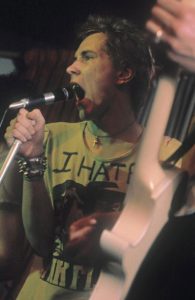 It’s not a perfect book, but what could be? And it’s by no means comprehensive. For that I recommend one of the thousands of yawn-fests cluttering up your local library shelves. But as a catalogue of this exhibit, its pretty good. However, some may not think so. I scanned a few fan sites and learned that many items on display in the exhibition are missing including some from the band’s and other personal collections. For example, handwritten notes and lyrics on display throughout the exhibition are not there. And many of the items from The Wall gallery aren’t included like the masks of the surrogate band, most of Water’s handwritten notes and drawings for the work, and the famous life-size Pink figure or the re-creation of the “Nobody Home” stage from live shows.
It’s not a perfect book, but what could be? And it’s by no means comprehensive. For that I recommend one of the thousands of yawn-fests cluttering up your local library shelves. But as a catalogue of this exhibit, its pretty good. However, some may not think so. I scanned a few fan sites and learned that many items on display in the exhibition are missing including some from the band’s and other personal collections. For example, handwritten notes and lyrics on display throughout the exhibition are not there. And many of the items from The Wall gallery aren’t included like the masks of the surrogate band, most of Water’s handwritten notes and drawings for the work, and the famous life-size Pink figure or the re-creation of the “Nobody Home” stage from live shows.
And, if we’re quibbling then what about the bed props from A Momentary Lapse of Reason or the suit of lights from A Delicate Sound of Thunder. Both are prominently on display in the exhibition. You can see them in the website. Likewise, the huge Division Bell heads. Both sets are on display. Yet there’s little about their very interesting story. At least Syd Barrett’s bike should be there. To some, these are important artifacts worth experiencing, even if only on the page.
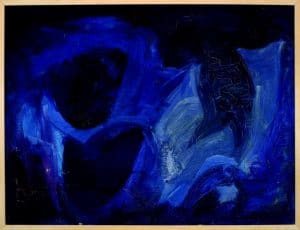 I guess publication limits everything so like the band’s Immersion box sets, this book can’t be everything. It still contains a lot of cool stuff and juicy snippets, especially the ‘new-to-us’ photographs and memorabilia. However, like all box sets, the book leaves stuff out, perhaps for yet another release at another time?
I guess publication limits everything so like the band’s Immersion box sets, this book can’t be everything. It still contains a lot of cool stuff and juicy snippets, especially the ‘new-to-us’ photographs and memorabilia. However, like all box sets, the book leaves stuff out, perhaps for yet another release at another time?
So, in conclusion, Their Mortal Remains is an excellent addition to any Pink Floyd library. With unique photography and memorabilia plus brilliant first witness accounts, especially from the visual side it’s still very relevant (even to the geeks). And to the rest of us, I think it will suffice, too. Nothing will recreate the true exhibition experience but this does give a pretty good slice of that and surely whets my appetite to go see the thing for real. By the way, can I borrow a couple of thou’ for the airfare to London, Geezer?
Tim Gruar
Pink Floyd: Their Mortal Remains – Accompanies the exhibition at the Victoria and Albert Museum, London (13th May – 1st October 2017) V&A Publications ($NZ79.99)
Contributors: Aubrey “Po” Powell is co-founder of design firm Hipgnosis and co-curator of the Pink Floyd: Their Mortal Remains exhibition. Mark Blake is a writer, editor, and author of the best-selling band biography Pigs Might Fly: The Inside Story of Pink Floyd (2007). Joe Boyd is a record and film producer who produced Pink Floyd’s first single, “Arnold Layne,” in 1967. Victoria Broackes is Senior Curator and Head of Exhibitions for the Department of Theatre and Performance at the V&A. Anna Landreth Strong is Curator of Modern and Contemporary Performance at the V&A. Howard Goodall is an Emmy-, Brit- and BAFTA-winning composer of choral music, stage musicals, film, and TV scores, and a distinguished broadcaster. Jon Savage is a broadcaster, music journalist, and author of 1966 and England’s Dreaming: The Sex Pistols and Punk Rock. Rob Young is author of Electric Eden: Unearthing Britain’s Visionary Music and former editor of The Wire magazine.
All photos courtesy of the Victoria & Albert Museum